
 ko
ko  English
English  Español
Español  中國人
中國人  Tiếng Việt
Tiếng Việt  Deutsch
Deutsch  Українська
Українська  Português
Português  Français
Français  भारतीय
भारतीय  Türkçe
Türkçe  Italiano
Italiano  Gaeilge
Gaeilge  اردو
اردو  Indonesia
Indonesia  Polski
Polski Python으로 Amazon 리뷰를 스크랩하는 것은 경쟁사 분석, 리뷰 확인, 시장 조사 등을 수행할 때 유용합니다. 이 문서에서는 Python, BeautifulSoup 및 Requests 라이브러리를 사용하여 Amazon에서 상품 리뷰를 효율적으로 스크랩하는 방법을 보여줍니다.
스크래핑 프로세스를 시작하기 전에 필요한 Python 라이브러리가 설치되어 있는지 확인하세요:
pip install requests
pip install beautifulsoup4아마존 페이지에서 상품 리뷰를 추출하는 데 중점을 두고 스크래핑 프로세스의 각 단계를 단계별로 살펴보겠습니다.
Amazon 상품 리뷰 페이지의 HTML 구조를 검사하여 스크랩할 요소인 리뷰어 이름, 평점, 댓글을 식별합니다.
제품 제목 및 URL:
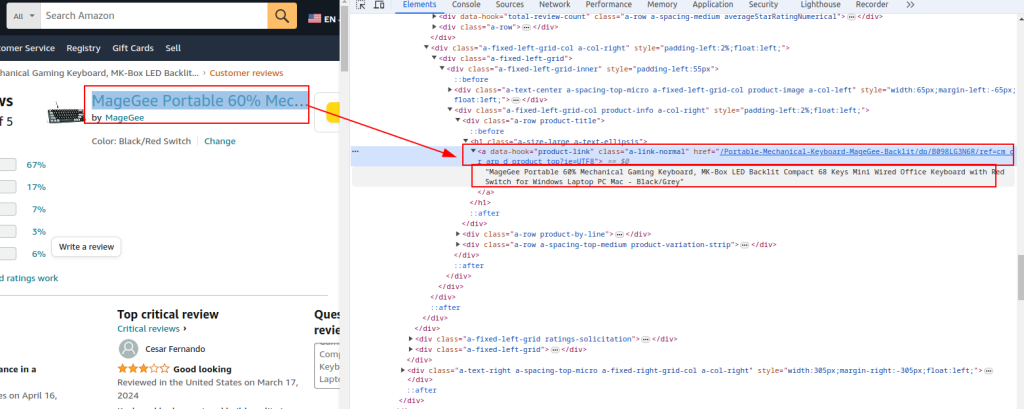
총 평점:
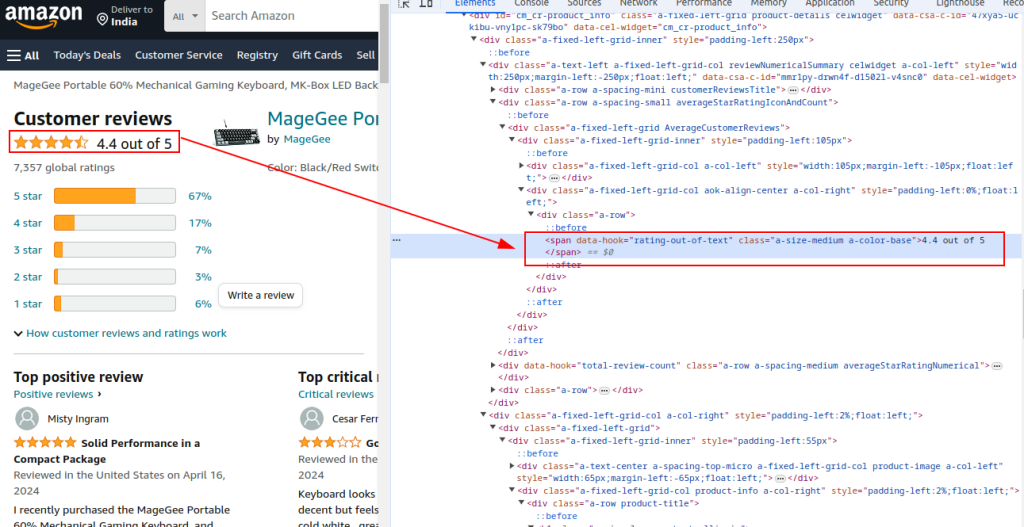
검토 섹션:
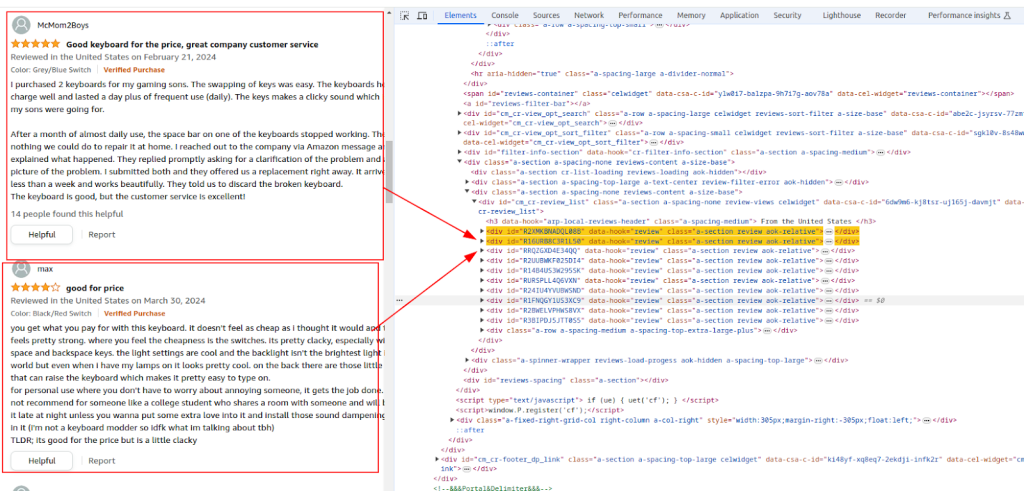
작성자 이름:
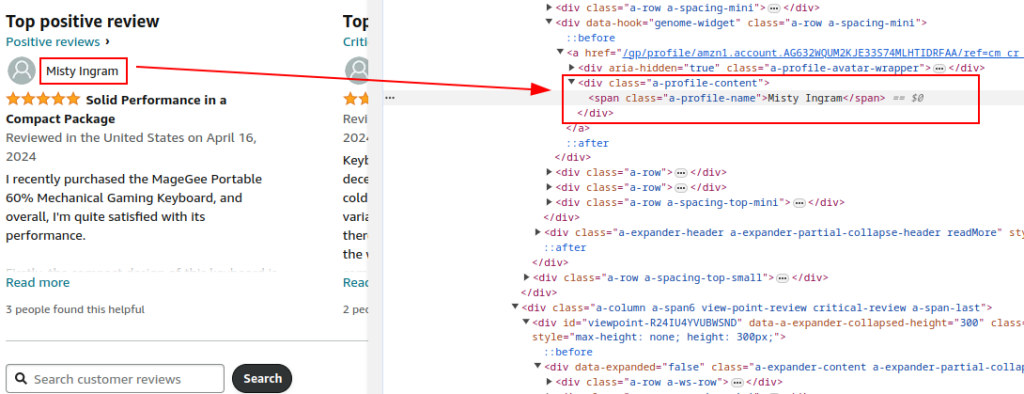
평가:
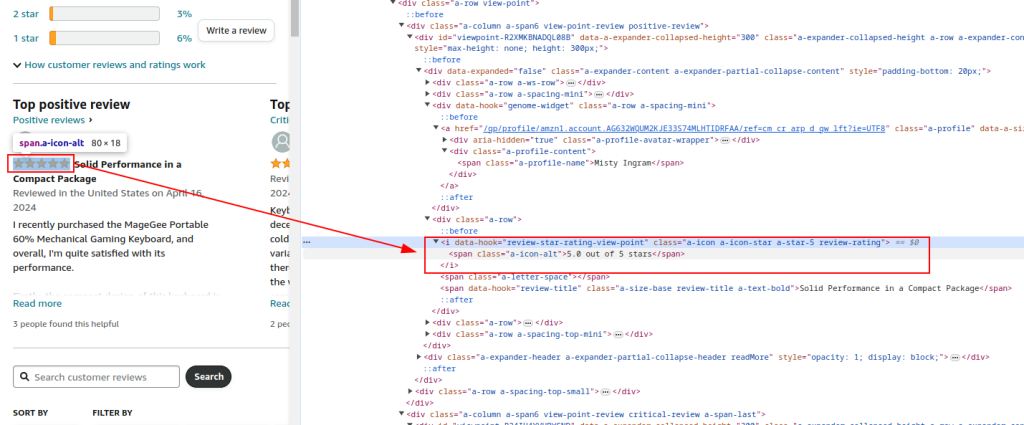
댓글:
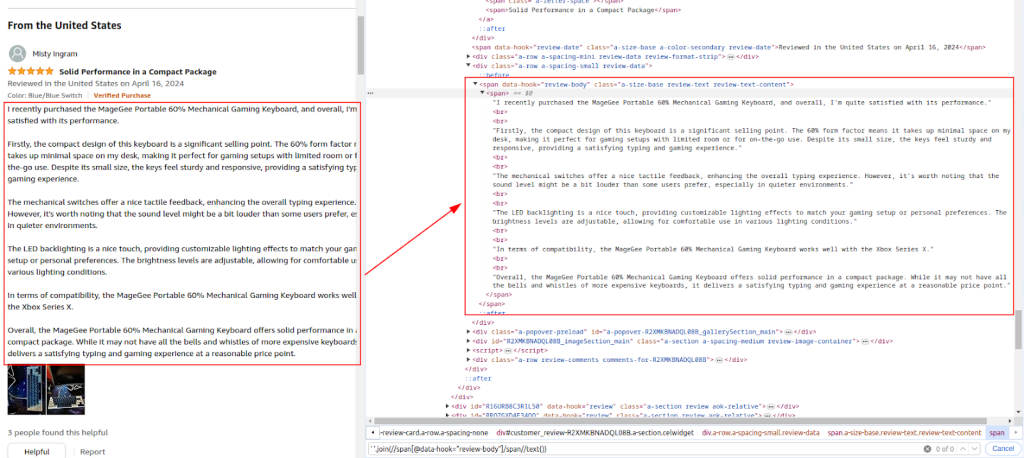
요청 라이브러리를 사용하여 Amazon 상품 리뷰 페이지로 HTTP GET 요청을 전송합니다. 합법적인 브라우저 동작을 모방하고 탐지를 피하도록 헤더를 설정하세요. 프록시와 완전한 요청 헤더는 Amazon에 의해 차단되는 것을 방지하는 데 필수적입니다.
프록시를 사용하면 아마존의 IP 금지 및 속도 제한을 피하기 위해 IP 주소를 순환하는 데 도움이 됩니다. 대규모 스크래핑의 경우 익명성을 유지하고 탐지를 방지하기 위해 프록시를 사용하는 것이 중요합니다. 여기서 프록시 세부 정보는 프록시 서비스에서 제공합니다.
인코딩 허용, 언어 허용, 리퍼러, 연결, 업그레이드-보안 요청과 같은 다양한 헤더를 포함하면 정상적인 브라우저 요청을 모방하여 봇으로 플래그가 지정될 가능성을 줄일 수 있습니다.
import requests
url = "https://www.amazon.com/Portable-Mechanical-Keyboard-MageGee-Backlit/product-reviews/B098LG3N6R/ref=cm_cr_dp_d_show_all_btm?ie=UTF8&reviewerType=all_reviews"
# 프록시 서비스에서 제공하는 프록시 예시
proxy = {
'http': 'http://your_proxy_ip:your_proxy_port',
'https': 'https://your_proxy_ip:your_proxy_port'
}
headers = {
'accept': 'text/html,application/xhtml+xml,application/xml;q=0.9,image/avif,image/webp,image/apng,*/*;q=0.8,application/signed-exchange;v=b3;q=0.7',
'accept-language': 'en-US,en;q=0.9',
'cache-control': 'no-cache',
'dnt': '1',
'pragma': 'no-cache',
'sec-ch-ua': '"Not/A)Brand";v="99", "Google Chrome";v="91", "Chromium";v="91"',
'sec-ch-ua-mobile': '?0',
'sec-fetch-dest': 'document',
'sec-fetch-mode': 'navigate',
'sec-fetch-site': 'same-origin',
'sec-fetch-user': '?1',
'upgrade-insecure-requests': '1',
'user-agent': 'Mozilla/5.0 (Windows NT 10.0; Win64; x64) AppleWebKit/537.36 (KHTML, like Gecko) Chrome/91.0.4472.124 Safari/537.36',
}
# 헤더와 프록시를 사용하여 URL로 HTTP GET 요청을 보냅니다.
try:
response = requests.get(url, headers=headers, proxies=proxy, timeout=10)
response.raise_for_status() # Raise an exception for bad response status
except requests.exceptions.RequestException as e:
print(f"Error: {e}")
URL, 제목, 총 평점과 같은 일반적인 제품 세부 정보를 추출하기 위해 BeautifulSoup을 사용하여 응답의 HTML 콘텐츠를 파싱합니다.
from bs4 import BeautifulSoup
soup = BeautifulSoup(response.content, 'html.parser')
# 공통 제품 세부 정보 추출
product_url = soup.find('a', {'data-hook': 'product-link'}).get('href', '')
product_title = soup.find('a', {'data-hook': 'product-link'}).get_text(strip=True)
total_rating = soup.find('span', {'data-hook': 'rating-out-of-text'}).get_text(strip=True)
식별된 XPath 표현식을 기반으로 HTML 콘텐츠를 계속 구문 분석하여 리뷰어 이름, 평점 및 댓글을 추출합니다.
reviews = []
review_elements = soup.find_all('div', {'data-hook': 'review'})
for review in review_elements:
author_name = review.find('span', class_='a-profile-name').get_text(strip=True)
rating_given = review.find('i', class_='review-rating').get_text(strip=True)
comment = review.find('span', class_='review-text').get_text(strip=True)
reviews.append({
'Product URL': product_url,
'Product Title': product_title,
'Total Rating': total_rating,
'Author': author_name,
'Rating': rating_given,
'Comment': comment,
})
Python에 내장된 CSV 모듈을 사용하여 추출된 데이터를 CSV 파일로 저장하여 추가 분석할 수 있습니다.
import csv
# CSV 파일 경로 정의
csv_file = 'amazon_reviews.csv'
# CSV 필드명 정의
fieldnames = ['Product URL', 'Product Title', 'Total Rating', 'Author', 'Rating', 'Comment']
# CSV 파일에 데이터 쓰기
with open(csv_file, mode='w', newline='', encoding='utf-8') as file:
writer = csv.DictWriter(file, fieldnames=fieldnames)
writer.writeheader()
for review in reviews:
writer.writerow(review)
print(f"Data saved to {csv_file}")
다음은 Amazon 리뷰 데이터를 스크랩하여 CSV 파일에 저장하는 전체 코드입니다:
import requests
from bs4 import BeautifulSoup
import csv
import urllib3
urllib3.disable_warnings()
# 아마존 상품 리뷰 페이지의 URL
url = "https://www.amazon.com/Portable-Mechanical-Keyboard-MageGee-Backlit/product-reviews/B098LG3N6R/ref=cm_cr_dp_d_show_all_btm?ie=UTF8&reviewerType=all_reviews"
# IP 인증으로 프록시 서비스에서 제공하는 프록시
path_proxy = 'your_proxy_ip:your_proxy_port'
proxy = {
'http': f'http://{path_proxy}',
'https': f'https://{path_proxy}'
}
# HTTP 요청에 대한 헤더
headers = {
'accept': 'text/html,application/xhtml+xml,application/xml;q=0.9,image/avif,image/webp,image/apng,*/*;q=0.8,application/signed-exchange;v=b3;q=0.7',
'accept-language': 'en-US,en;q=0.9',
'cache-control': 'no-cache',
'dnt': '1',
'pragma': 'no-cache',
'sec-ch-ua': '"Not/A)Brand";v="99", "Google Chrome";v="91", "Chromium";v="91"',
'sec-ch-ua-mobile': '?0',
'sec-fetch-dest': 'document',
'sec-fetch-mode': 'navigate',
'sec-fetch-site': 'same-origin',
'sec-fetch-user': '?1',
'upgrade-insecure-requests': '1',
'user-agent': 'Mozilla/5.0 (Windows NT 10.0; Win64; x64) AppleWebKit/537.36 (KHTML, like Gecko) Chrome/91.0.4472.124 Safari/537.36',
}
# 헤더와 함께 HTTP GET 요청을 URL로 전송하고 예외를 처리합니다.
try:
response = requests.get(url, headers=headers, timeout=10, proxies=proxy, verify=False)
response.raise_for_status() # Raise an exception for bad response status
except requests.exceptions.RequestException as e:
print(f"Error: {e}")
# BeautifulSoup을 사용하여 HTML 콘텐츠 구문 분석하기
soup = BeautifulSoup(response.content, 'html.parser')
# 공통 제품 세부 정보 추출
product_url = soup.find('a', {'data-hook': 'product-link'}).get('href', '') # Extract product URL
product_title = soup.find('a', {'data-hook': 'product-link'}).get_text(strip=True) # Extract product title
total_rating = soup.find('span', {'data-hook': 'rating-out-of-text'}).get_text(strip=True) # Extract total rating
# 개별 리뷰 추출
reviews = []
review_elements = soup.find_all('div', {'data-hook': 'review'})
for review in review_elements:
author_name = review.find('span', class_='a-profile-name').get_text(strip=True) # Extract author name
rating_given = review.find('i', class_='review-rating').get_text(strip=True) # Extract rating given
comment = review.find('span', class_='review-text').get_text(strip=True) # Extract review comment
# 각 리뷰를 사전에 저장
reviews.append({
'Product URL': product_url,
'Product Title': product_title,
'Total Rating': total_rating,
'Author': author_name,
'Rating': rating_given,
'Comment': comment,
})
# CSV 파일 경로 정의
csv_file = 'amazon_reviews.csv'
# CSV 필드명 정의
fieldnames = ['Product URL', 'Product Title', 'Total Rating', 'Author', 'Rating', 'Comment']
# CSV 파일에 데이터 쓰기
with open(csv_file, mode='w', newline='', encoding='utf-8') as file:
writer = csv.DictWriter(file, fieldnames=fieldnames)
writer.writeheader()
for review in reviews:
writer.writerow(review)
# 확인 메시지 인쇄
print(f"Data saved to {csv_file}")
결론적으로, 신뢰할 수 있는 프록시 서버를 선택하는 것이 웹 스크래핑을 위한 스크립트 작성의 핵심 단계라는 점을 강조하는 것이 중요합니다. 이를 통해 차단을 효과적으로 우회하고 봇 방지 필터로부터 보호할 수 있습니다. 스크래핑에 가장 적합한 옵션은 높은 신뢰도와 동적 IP 주소를 제공하는 주거용 프록시 서버와 빠른 속도와 운영 안정성을 제공하는 정적 ISP 프록시입니다.
댓글: 0